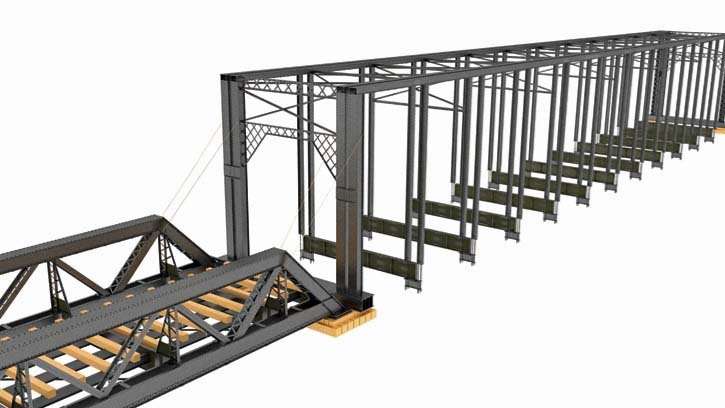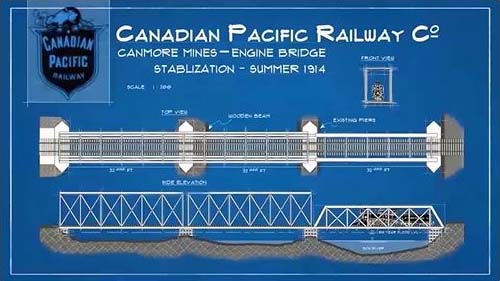
of Canmore Landmark
Canmore Alberta - The Engine Bridge, one of Canmore's iconic landmarks, is a cornerstone of the town's trail system, linking Mineside and
Townside, and of the town's visual identity and cultural heritage.
And yet, as Jerry Auld, a Canmore writer, publisher of Imaginary Mountain Surveyors and digital animator, discovered as he built a 10 minute animated history
of the bridge, which can be seen on the Canmore Museum and Geoscience Centre website, its history is practically blank.
"There's not a single photo of its construction," said Auld.
"There's not a single plan of its construction. There's not a telegram. There's nothing, There's no record. This bridge came out of nowhere and is
anchoring the town, and it just blows me away that something so important has no past."
The Toronto Bridge Co. (later renamed the Dominion Bridge Co.) manufactured the Engine Bridge in 1880.
The CPR erected the bridge, which is comprised of a smaller half-through section and larger box-like truss section, over the Bow River in 1919 to replace a
wooden bridge that had caught fire, a regular hazard with spark-belching steam locomotives.
And that's where the documented story of the Engine Bridge ends.
The only plan Auld did manage to find of the bridge was produced in 1984 when the Town of Canmore removed the wooden piers and replaced them with concrete
piers.
Auld came up against this lack of documentation shortly after he set out to build his animated history of the bridge as part of a larger digital animation
project he has been working on about Canmore's history as told through maps.
And what Auld at first assumed would be a simple, straightforward, part of that project became something much larger.
"At one point I decided to try and break it down into small bite-sized pieces and thought, I'll do the Engine Bridge first because it's small, it's
central, and how hard could it be?"
After approaching the Canmore Museum, CPR archives in Montreal and the Glenbow Museum in Calgary, along with Canmore coal miners and historians, with little to
no luck, Auld quickly realized telling the bridge's story was going to be much harder than he thought.
With little to go on, Auld had to make conclusions about the bridge based on his intuition and historical bridge-building practices and
technology.
The lack of plans and information also forced him to spend a lot of time crawling around the bridge just trying to understand how it was
constructed.
It took Auld over 1,000 hours to produce his animated history, but the work paid off.
Through Auld's video, we get to see step-by-step just how the Engine Bridge and its predecessors were erected.
And that brings some surprises.
The truss bridge, for example, isn't a single rigid structure.
The trusses, which hang from the top beams, or upper chords, are designed to swing, giving the bridge a remarkable amount of latitude to move.
"If you look at the trusses, they're all swinging. They're not actually bolted in or riveted in, they're swinging so the whole thing can move," said
Auld.
"The bridge has an enormous ability to manage and adjust itself. When I walk across it now, I walk across it with a very different feeling. I'm more aware
that those pieces are not all rigid. They're all completely able to move with the stress of the bridge. I find it fascinating that they could build such an
incredibly cool truss system, and I just never saw it. I just thought the whole thing was rigid."
As well, Auld said the bridge would have been brought out to Canmore in large pre-assembled parts, allowing a small crew of workers to assemble it with large
wrenches.
"It's an incredibly versatile design for whatever you need. For the materials on hand that was an ingenious design. It still is, it's perfect, it still
works," said Auld.
Auld's animated history of the Engine Bridge, as much as it is about the bridge, is also as much about the site where the bridge sit and its importance to
Canmore and the coal mines, which operated from 1887 to 1979.
And, as a bonus, both the Goat, the Canmore Mines steam locomotive that is now at Heritage Park in Calgary, and the blue diesel locomotive that was in use when
the mine closed, make an appearance crossing the bridge with coal cars in tow.

Auld even made his own blueprints and telegrams, imagining the conversation between the CPR and mine managers.
Lachlan Mackintosh, director of CMAGS, said he was inspired to share Auld's animated history of the Engine Bridge on the museum's website as an engaging way of
sharing the story of an iconic part of Canmore's history.
"It's a different way of looking at our storytelling, and that is the main reason we want to have it hosted on our site," said
Mackintosh.
"The museum is always interested in developing new audiences and younger audiences, and the video is so great for that."
He added one of the challenges the museum faces is that so many of Canmore's historical structures are gone that it can be difficult to tell stories about
Canmore's past.
"There's the Lamphouse, which we're working on, and there's Gerry Stephenson's historical tours, which are fantastic for connecting with what still
remains at the mine sites, but the Engine Bridge is there all four seasons," said Mackintosh.
"It's alive and kicking and still a part of our culture."
Along with a new appreciation for how the bridge was constructed, Auld said he also came to appreciate how the bridge serves as a metaphor for Canmore itself,
given that the community is such a mix of old and new.
"It is a good metaphor for Canmore," he said.
"I just assumed the bridge was there, solid, stable, dependable, reliable, iconic, that was my Canmore, but the more you look at it, the closer you look
at it, the more surprising it is, the two parts of that bridge are completely different.
"They work together perfectly, but they are completely different structures, 100 percent different design, different methods, different ways of handling
the stress, and yet they look like they belong together."
Author unknown.
under the provisions in
Section 29 of the Canadian
Copyright Modernization Act.


